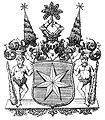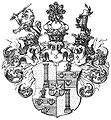Güldenstern (noble family)
Güldenstern is the German name of the Danish - Swedish noble family Gyldenstierne ( Danish ) or Gyllenstierna ( Swedish ).
history
Denmark
The lineage of the widespread family is traced back to the knight Nils Eriksson zu Ågård in Jutland , who is documented in 1314. Under his great-grandchildren Knud, Peder and Erik Nilssøne, the family split into the three branches Restrup, Ågård and Demstrup. The family held high offices in the Kingdom of Denmark. In Denmark, the family died out in 1729.
Sweden
The family had also been based in Sweden since the first half of the 15th century. Erik Eriksson af Fågelvik married Kristina, a daughter of the Swedish King Charles VIII. One of the couple's sons, Nils Eriksson Gyllenstierna, was the father of Christina Gyllenstierna († January 1559 ). She became the wife of the Swedish administrator Sten Sture the Younger and after his death continued the resistance against Christian II .
Nils Göransson Gyllenstierna was raised to the Swedish baron in 1569 . After Skåne became Swedish, a branch of the Danish family resident there, now extinct, was accepted into the Swedish knight's house . The Vinstrop branch was given the baron status in 1651, while four other branches: Björkesund , Eriksberg , Steninge and Fogelvik were given the status of counts in Sweden . All of these branches are extinct today. On the other hand, branches of the simply noble (von) Gyllenstierna bloom to this day.
Today the seat of the family foundation is Krapperup Castle in Skåne (owned by the family since 1809). The Bjersgård estate in Klippan is still owned by the family to this day . The family's historical possessions were Svaneholm Castle (1611 to the beginning of the 18th century), Nynäs Castle (1600–1860), and Fågelvik Castle in Valdemarsvik (1446–1711). Erik Karlsson Gyllenstierna (1602–1657), Swedish Imperial Councilor, had the Ericsberg Castle, named after him, built from 1650 , one of the most important Swedish baroque castles, Count Carl Gyllenstierna around 1695, the Steninge Castle .
Norway
The Danish knight Mogens Henriksen Gyldenstierne († 1569) was lord of Akershus from 1527 . The Danish diplomat Alex Gyldenstierne (approx. 1542-1603) was governor general of Norway from 1588 to 1601.
Pomeranian
From the marriage of the Swedish admiral Johann Güldenstern and the Countess Siegfriede von Brahe lived a son Sigismund Gyllenstierna , baron of Lundholm and Vogelwick, castellan of Danzig and Starost zu Stuhm . He died on June 30, 1666. With his wife Anna Czema , the castellan of Stelins and Starosten on Stum's heir, he had two sons and two daughters, who died early. This house in Prussia went out in 1676 with his nephew Maximilian von Güldenstern .
Duchy of Bremen and Verden
Nils Gyllenstierna (1648–1720) was Governor General of the Duchies of Bremen and Verden from 1698 to 1710 .
coat of arms
The family coat of arms shows a golden, seven-pointed star in blue.
Literary and trivia
The gender name appears in the form of Guildenstern in William Shakespeare 's tragedy Hamlet .
See also : Rosenkranz & Güldenstern
In Stade , the local sports club TuS Güldenstern Stade is named after the family.
Name bearer
- Christina Gyllenstierna (1494–1559), wife of the Swedish Governor Sten Sture the Younger
- Nils Gyllenstierna (1526–1601), Swedish Chancellor
- Göran Nilsson Gyllenstierna (1575–1618), Swedish Imperial Admiral
- Sigismund Gyllenstierna (1598–1666), castellan of Danzig
- Göran Göransson Gyllenstierna (1601–1646), Swedish admiral
- Johan Göransson Gyllenstierna (1635–1680), Swedish Imperial Councilor
- Johan Nilsson Gyllenstierna (1569–1617), Swedish Imperial Admiral
- Nils Gyllenstierna (1648–1720), Swedish field marshal, 1698–1710 Governor General of the Duchies of Bremen and Verden
literature
- Leopold von Zedlitz-Neukirch : New Prussian Nobility Lexicon . Volume: Supplement. Leipzig 1839, p. 200 ( books.google.de ).
- C. With .: Gyldenstjerne, Anders - Gyldenstjerne, Sibylle . In: Carl Frederik Bricka (Ed.): Dansk biografisk Lexikon. Tillige omfattende Norge for Tidsrummet 1537-1814. 1st edition. tape 6 : Gerson-H. Hansen . Gyldendalske Boghandels Forlag, Copenhagen 1892, p. 365-397 (Danish, runeberg.org ).
- Nils G. Bartholdy: Gyldenstierne . In: Svend Cedergreen Bech , Svend Dahl (eds.): Dansk biografisk leksikon . Founded by Carl Frederik Bricka , continued by Povl Engelstoft. 3. Edition. tape 5 : Frille – Hanssen . Gyldendal, Copenhagen 1980, ISBN 87-01-77403-4 (Danish, biografiskleksikon.lex.dk ).
- Gyllenstierna . In: Theodor Westrin (Ed.): Nordisk familjebok konversationslexikon och realencyklopedi . 2nd Edition. tape 10 : Gossler-Harris . Nordisk familjeboks förlag, Stockholm 1909, Sp. 763-775 (Swedish, runeberg.org ).
- Gyllenstierna . In: Herman Hofberg, Frithiof Heurlin, Viktor Millqvist, Olof Rubenson (eds.): Svenskt biografiskt handlexikon . 2nd Edition. tape 1 : A-K . Albert Bonniers Verlag, Stockholm 1906, p. 428-433 (Swedish, runeberg.org ).
- Gyllenstierna, släkt In: Svenskt biografiskt lexikon . (Swedish)













